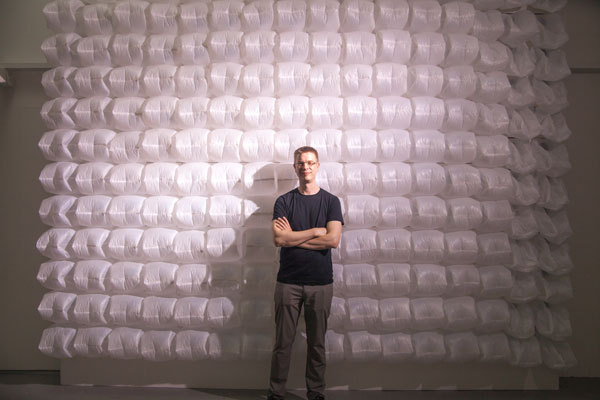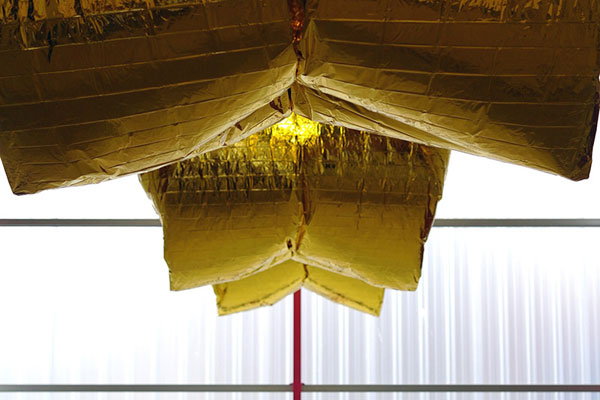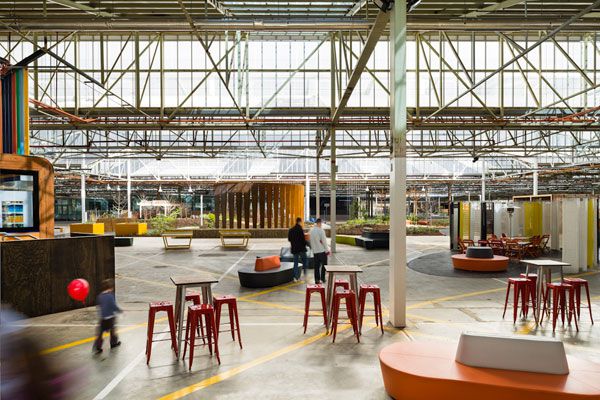Recently exhibited at DECK and VivoCity, The Breathing Wall is an art installation that creates interactivity out of air, 96 plastic bags and customised electronics, made by international media artist, Nils Völker, in collaboration with Philips.

April 15th, 2015
Nils Völker creates artworks that lie in the intersection of technology and art through the means of cheap materials and customised electronic parts. Showcased in Singapore for the first time, while exploring the intangible – the air that we breathe – Völker created his signature installation out of 96 ordinary white plastic bags.

The Breathing Wall, DECK, 2015.
Inflated and deflated in controlled rhythms, the wall-mounted installation reacts instantaneously to the movements of its viewer and recomposes itself as soon as it detects zero activity. The bags will then gently wobble to the natural qualities of its environment, creating an organic installation with an atmospheric presence in the various spaces it inhabits.
Similar large scale installations by Völker, made out of different materials such as cushions, have been exhibited in major museums and art spaces worldwide, including an upcoming piece at 21_21 Design Sight in Tokyo. In an email interview, he tells us how he got to experiment with plastic bags.

NINETEEN, The Netherlands, 2015.
How does the installation in Singapore, The Breathing Wall differ from One Hundred and Eight that you created in 2010?
One Hundred and Eight was the very first work based on inflating plastic bags. Back then I had more or less no idea about electronics and not much more about programming. So the technical background of the new installation is completely different and much more elaborate. But from the outside, what the visitor sees is very similar. Since 2010, I’ve realised many different installations, experimenting with cushions of different shapes, sizes, with materials emitting a loud sizzling sound or cushions having light inside but I have always really liked the size and shape of the garbage bags that I used for One Hundred and Eight so this was the perfect opportunity to use them once again.
What led you to become a media artist?
Originally, I have a background as a graphic designer. A lot of coincidences led me to finally become a media artist. Years ago, I was playing around with a Lego-set with which you can build small robots, just for fun during my free time. Over time, my ideas grew bigger and bigger so I switched to real electronics and actually discovered a whole new world.
And in this new world, you took a simple, everyday material and created installations of mesmerizing beauty. Where did this idea stem from and what challenges did you face?
A while ago, I was lucky to get hold of a large number of computer cooling fans for a very good price. So I simply had to buy them, although at that point I had no idea what they could be useful for. When they arrived, I started experimenting with the fans and things I had lying around. Finally, some simple garbage bags turned out to be surprisingly nice when inflated and deflated. In the beginning, the biggest challenges were rather technical, as I had no experience and knowledge in electronics at all. So I had to go through some trials and way more errors. Nowadays, the challenge with this kind of installations is rather the programming of the animation and to find the best ways to create movements on the wall.
What are the technological elements involved?
Each bag is inflated/deflated by two fans which are all individually addressable by a micro controller. There are several custom made circuit boards needed for the communication and switching of the power running the fans.
The exhibition grew over time with alterations to various materials and form. What is next?
Several exhibitions are planned all over the world. A very nice one will be in a Museum called 21_21 Design Sight in Tokyo. It will include Thirty Three, a very large installation of mine which will be moving based on tidal data from Tokyo harbor.
Nils Völker
nilsvoelker.com
INDESIGN is on instagram
Follow @indesignlive
A searchable and comprehensive guide for specifying leading products and their suppliers
Keep up to date with the latest and greatest from our industry BFF's!

A longstanding partnership turns a historic city into a hub for emerging talent

How can design empower the individual in a workplace transforming from a place to an activity? Here, Design Director Joel Sampson reveals how prioritising human needs – including agency, privacy, pause and connection – and leveraging responsive spatial solutions like the Herman Miller Bay Work Pod is key to crafting engaging and radically inclusive hybrid environments.

Gaggenau’s understated appliance fuses a carefully calibrated aesthetic of deliberate subtraction with an intuitive dynamism of culinary fluidity, unveiling a delightfully unrestricted spectrum of high-performing creativity.

In this candid interview, the culinary mastermind behind Singapore’s Nouri and Appetite talks about food as an act of human connection that transcends borders and accolades, the crucial role of technology in preserving its unifying power, and finding a kindred spirit in Gaggenau’s reverence for tradition and relentless pursuit of innovation.

Can you design a workplace like you were writing a book? Bean Buro’s latest project for UBER Hong Kong indicates that maybe you can.

The South Australian Government has been awarded the first 6 Star Green Star – Communities certification for an urban renewal project by the Green Building Council of Australia (GBCA) for the redevelopment of Tonsley.
The internet never sleeps! Here's the stuff you might have missed

Throughout his life, Ong Tze Boon has made a real difference to both people and place. He is a man of vision who has changed the architectural landscape of Singapore and South-East Asia and strives to make a better world for the future.

As Kvadrat announces its full independence, Njusja de Gier shares some insight on her fascinating and rather unorthodox career path.